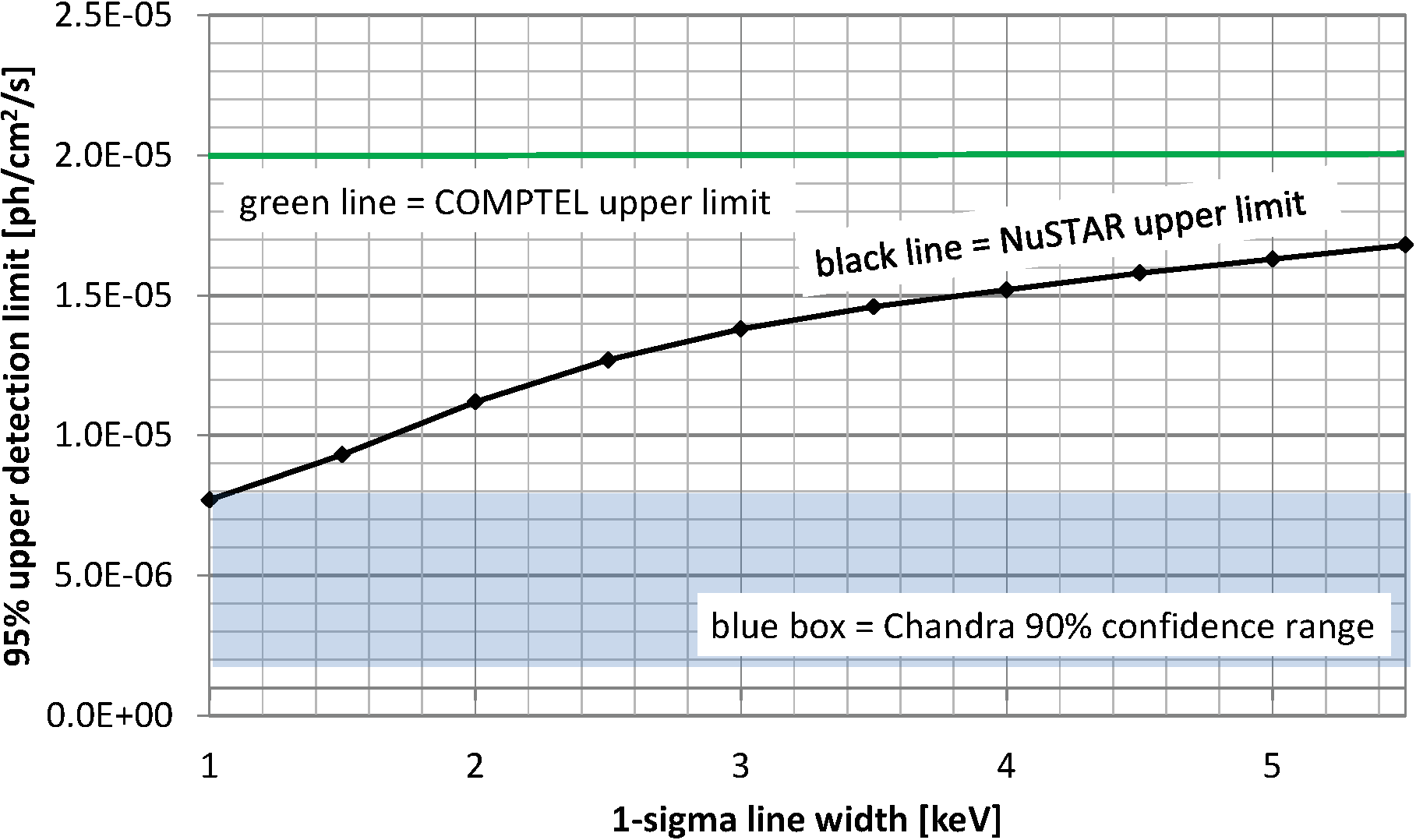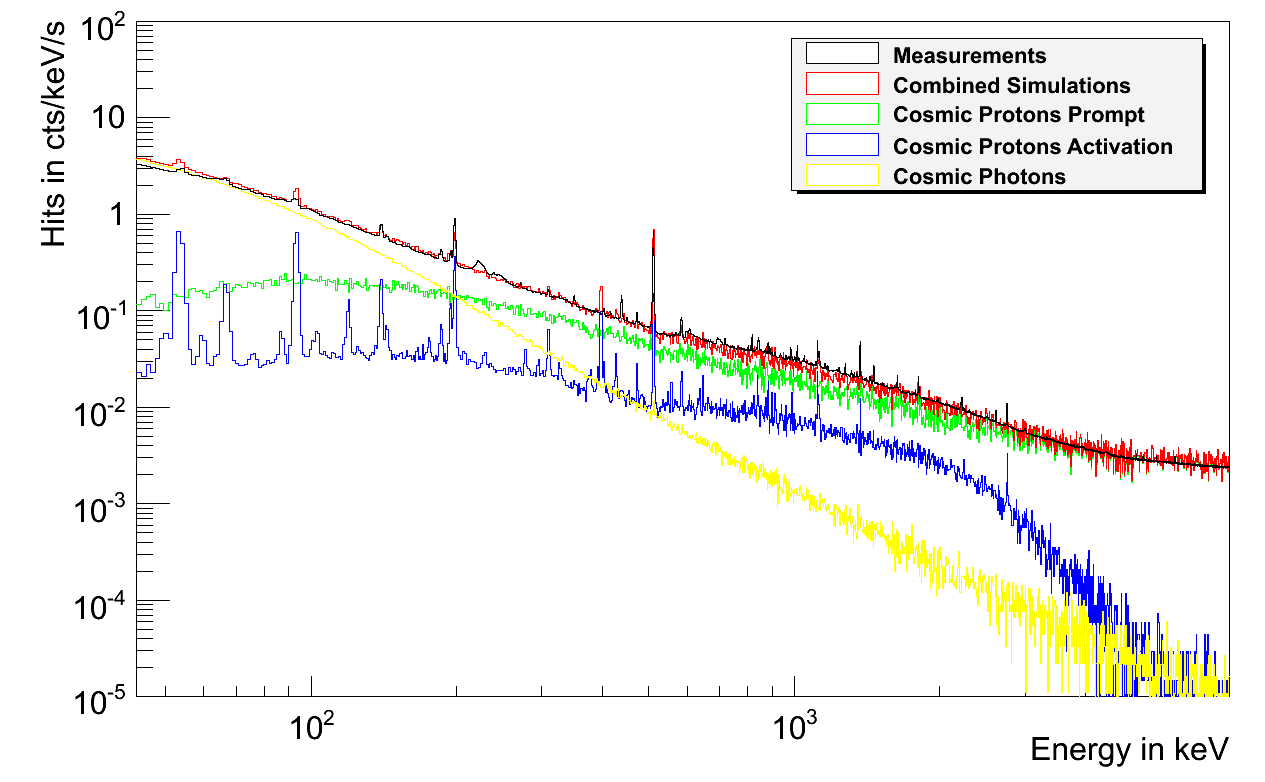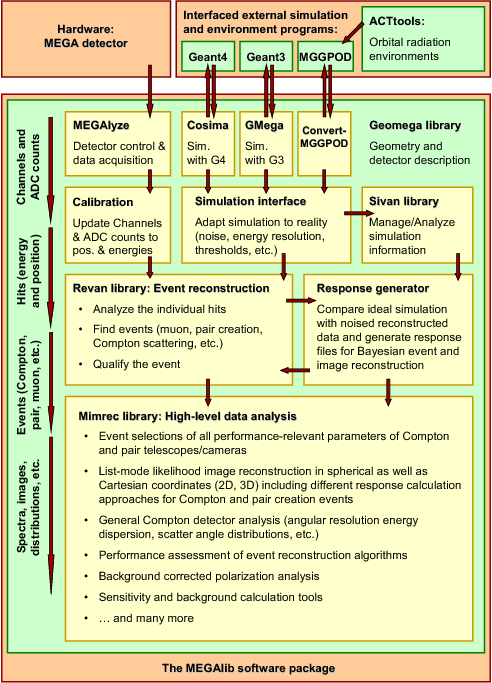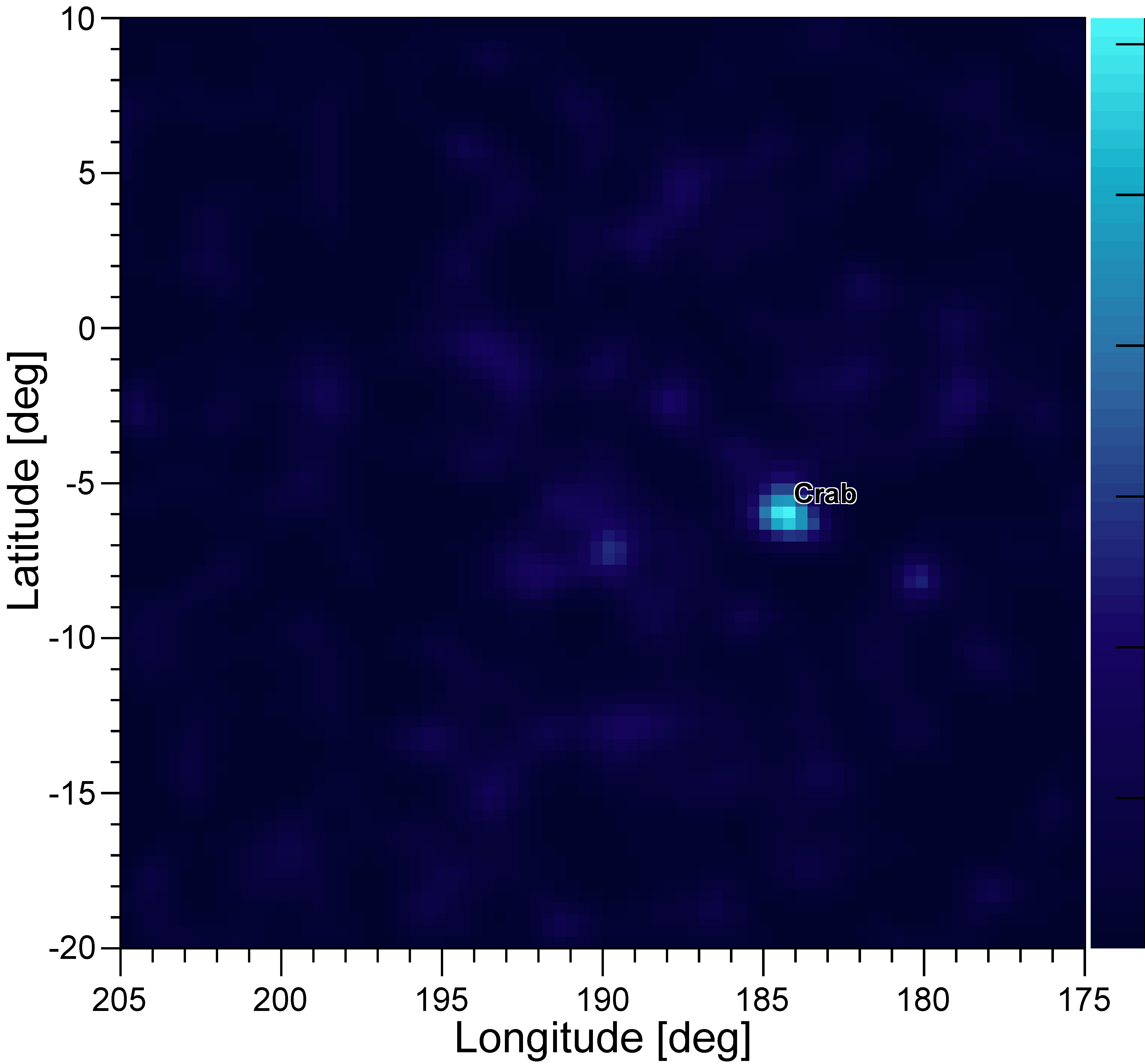Research Interests
My research interests center around hard X-ray and soft-to-medium-energy gamma-ray telescopes: development of new simulation and analysis techniques, optimization and performance prediction of future instruments as well as astrophysics with an emphasis on nuclear line science, supernovae, and the reanalysis of COMPTEL data.
Nuclear line science: Supernovae, nucleosynthesis, and dark matter?

While COMPTEL and INTEGRAL did ground-breaking work understanding galactic nucleosynthesis, they left many questions unaddressed, since answering them would require the sensitivity of a next generation Compton telescope or a gamma-ray lens instrument. Among those open questions is, for example, the explosion mechanism of type Ia supernovae, which can be unraveled by the detection and the analysis of e.g. the 847 keV line emission (e.g. analyzing its strength, shape, light curve, etc.).

Another important open question concerns the 511 keV positron annihilation emission. The measurement of the 511 keV line with INTEGRAL revealed a dominating emission around the bulge of the Milky Way with some asymmetry. However, INTEGRAL was not able to determine the origin of that emission. Theories range from novae, supernovae, low-mass X-ray binaries to dark matter – and any combination of them. Figure 1 shows a simulation of the 511-keV emission using the GRIPS Compton telescope after a 5 year mission which corresponds to ~10 times better sensitivity than INTEGRAL in the inner bulge. The simulation assumes that the galactic bulge consists only of point sources. The total bulge emission is consistent with the INTEGRAL results, and all individual point sources are below the detection limit of INTEGRAL. In the above case GRIPS would be clearly capable of detecting the point sources. For more details see Zoglauer et al., New Astronomy Reviews 52(7-10), 2008.
Further questions center around the production of 26Al and 60Fe. Both isotopes are expelled during core-collapse supernovae, but 26Al most likely is expelled also during the Wolf-Rayet phase of massive OB stars. However, due to the limited imaging capabilities and sensitivity of COMPTEL and INTEGRAL as well as the long lifetime of 26Al, no detection of such a star was possible. Figure 2 shows a simulation of what a MEGA-like instrument, achieving ~10 times better sensitivity than COMPTEL at this energy, would see in the Cygnus region. It would clearly detect the OB-associations in the light of radioactive 26Al. For more details see Zoglauer, PhD thesis, TU Munich 2005.

Another tool to probe nucleosynthesis is 44Ti. This isotope is produced deep in the exploding star during both core-collapse and thermonuclear supernovae. Its yield, and distribution in a supernova remnant and the resulting line shape and shift are key tools to understand supernovae and to study their explosion mechanisms as well as potential asymmetries. The 44Ti decay chain (44Ti -> 44Sc -> 44Ca) can be detected via nuclear de-excitation lines of 44Sc at 68 and 78 keV and of 44Ca at 1157 keV, as well as via a 4.1 keV 44Sc fluorescence line. However, for the time being, Cas A remains the only Galactic source (SN1987A is in the LMC) for which the 44Ti emission has been indisputably measured by several telescopes (e.g. Iyudin et al. 1994, Grefenstette et al. 2014). A second potential source, “Vela Jr” (RX J0852.0-4622), has a marginal detection by COMPTEL in the 1.157 keV line (Iyudin et al. 1998), but was not detected by INTEGRAL in the 68 and 78 keV lines despite extensive searches (Renaud+ 2006). A third source, Tycho, has a marginal detection by Swift/BAT (Troja et al. 2014), but the result is not consistent with COMPTEL observations. The fourth candidate is G1.9+0.3, for which Borkowski et al. (2010, 2013) have recently reported the detection of a 4.1 keV 44Sc fluorescence line with a corresponding 68-keV, however only upper limits have been detected so far with NuSTAR in the 68 keV or 78 keV line (see Figure to the right from Zoglauer et al., ApJ, 2014).
Advanced event reconstruction techniques

Gamma-ray detectors, especially if they measure photons via Compton scattering and pair creation, are a formidable challenge for data analysis: Gamma rays, as well as non-photon background particles, interact multiple times in the detector. The data analysis algorithms then have to determine the sequence of the interactions as well as if the event originated from a (good) photon or from (bad) non-photon background. For this task novel Bayesian and neural network algorithms have been developed which significantly outperform previously existing algorithms. Figure 4 shows an example using simulations of the Nuclear Compton Telescope. For more details see Zoglauer et al., Proc. SPIE 6700, 2007 and Zoglauer et al., IEEE NSS Conf. Rec. 2007. However, since the methods are limited by the time required to create the Bayesian data spaces and to train the networks, a reduction of the Compton data was necessary resulting in information loss. By optimizing these simplifications as well as with advances in CPU technology future performance improvements are within reach.
Development of novel imaging methods

One important step during data analysis is determining the original source distribution from the measured data using image deconvolution techniques. Due to the complexity of the response of modern Compton telescopes, a key problem is finding a suitable response simplification. Several response representations have been developed (see e.g. Zoglauer PhD thesis, Zoglauer NIMA, 652, 2011) ranging from simple Gaussian approximations to more complex partly-binned response representations which are capable of performing either only spatial (see Figure 5 for an example with COMPTEL data, which is a clear improvement compared to the original COMPTEL images from Zoglauer NIMA, 652, 2011) or combined spatial-spectral deconvolution. While the latter achieve the best imaging performance, they are also limited by their extreme computational requirements. As a consequence, all current implementations have not yet reached their full potential. In addition several different types of image reconstruction algorithms based on maximum-entropy or multi-resolution, which have been successfully used with COMPTEL, have never been applied to the next generation of Compton telescopes.
Advances in the simulation of the space radiation environment for hard X-ray and gamma-ray telescopes with Geant4

Simulations allow for the prediction of the performance and for the optimization of the setup, the orbit, etc. of future instruments long before they are actually built. Therefore, simulations are a key tool in the development of new gamma-ray instrumentation. However, those simulations are only as good as the software tools used such as Geant4. This is especially important for space-borne gamma-ray telescopes operating in the nuclear line regime (tens of keV to several MeV) because their background is in many cases dominated by detector activation. Since those activation scenarios cannot be handled by standard Geant4, a special application, Cosima, has been developed, which extends Geant4 to handle detector activation due to hadron interactions in a space radiation environment. Figure 6 shows the current performance of Cosima/Geant4 by comparing the measured background from TGRS with simulations. While the agreement between simulations and measurements is rather good, Geant4’s capability to handle e.g. meta-stable states and to generate the correct isotopes during hadron interaction requires further improvements. For more details consult the following publications: Zoglauer et al., IEEE NSS Conf. Rec. 2008 and Zoglauer et al., IEEE NSS Conf. Rec. 2009.
Development of an integrated simulation and data analysis toolset

In order to leverage the fact that many gamma-ray instruments in space and on ground have the same data analysis steps in common and in order to be able to compare their performance side-by-side, a universal tool, MEGAlib (the Medium-Energy Gamma-ray Astronomy library), has been developed. As can be seen in Figure 6, MEGAlib encompasses the complete data-analysis path from simulations and measurements via event reconstruction to high-level data analysis such as image reconstruction. Due to its modular and versatile design, MEGAlib can be applied to almost any gamma-ray detector. Indeed, MEGAlib is the key analysis tool for several gamma-ray instruments such as MEGA/GRIPS, NCT, HEMI, and recently also COMPTEL and is used (at least partly) for many more instruments such as ACT, GRI, NuSTAR, etc. MEGAlib is designed completely object-oriented and written in C++. It is freely available and continuously updated with the latest developments. A general overview of MEGAlib can be found in Zoglauer et al., NewAR 50 (7-8), 2006.
Development, modeling, and optimization of novel gamma-ray detectors

The next generation of hard X-ray and gamma-ray telescopes will advance the sensitivity limit by a factor of 10 to ~200. This requires new technologies, an increased effective area, and improved background suppression and identification. In order to find the optimum parameters, detailed simulations have to be performed which compare different detector technologies in a realistically simulated space radiation environment. The result of such a process can be found in Figure 8. The NuSTAR focal plane module has been fully simulated to find an optimum orbit (given the constraints of the launch vehicle and data downlink), and its shield and its aperture stop have been optimized to minimize the instrumental background (within weight, size, and material constraints). For further examples on how to carry out the modeling and optimization please consult e.g. Zoglauer et al., NewAR 50(7-8), 2006 for the MEGA instrument, Zoglauer et al, NSS Conf. Rec. 2006 for the Gamma-Ray Imager (GRI), Zoglauer et al, NSS Conf. Rec. 2009 for the High Efficiency Multimode Imager (HEMI).

Another key example is the balloon-borne Compton telescope COSI (formerly known as NCT). COSI deploys novel Germanium double-sided strip detectors. These enable unprecedented energy resolution and position resolution for a space Compton telescopes and allow for improved background suppression, a wider field-of-view, better angular resolution, and polarization measurements. COSI was designed, optimized, and built in Berkeley and had two successful flights on high altitude balloons from Fort Sumner, New Mexico. During its second test flight COSI successfully measured the Crab pulsar and nebula with ~6 sigma (see Figure 9). This was the first observation of an extra-terrestrial source of a modern, compact Compton telescope. In the future, several long-duration (~100 days) balloon flights are planned with COSI. The goals include the measurement of the polarization of gamma-ray burst and other compact objects, as well as nuclear line science including 26Al, 60Fe, as well as to unravel the mysteries behind the Galactic 511 keV emission. The ultimate goal for COSI to build and launch a satellite mission.
Reanalyzing COMPTEL data

Besides balloon-borne, terrestrial, and envisioned Compton telescopes, a key application area of the novel simulation and analysis tools is the original COMPTEL dataset. Since no mission is in sight that will challenge COMPTEL’s imaging performance between ~2 and ~30 MeV, it is important to optimize COMPTEL’s data analysis techniques. Since the original methods were developed for computers in the early 90’s, the latest analysis techniques have the potential to improve COMPTEL’s sensitivity and thus improve upon COMPTEL’s results. Examples of the reanalysis of COMPTEL data can be seen in Figure 5 and in Figure 10. The latter is the first Crab image using data above COMPTEL’s original energy range, between 30 and 50 MeV. This energy range is very challenging due to a low Compton cross-section and the requirement to measure/reconstruct the full energy of the photon for Compton reconstruction as well as due to the low angular resolution of pair telescopes like Fermi (large Molière scattering, unknown recoil of the nucleus). Figure Z, however, has an angular resolution of 1.6 degrees and Crab was detected at the ~6σ level. It demonstrates the possibilities a reanalysis of COMPTEL data might open: it has the potential to yield improvements in the nuclear line regime (e.g. improved 26Al sky maps) as well as to detect a few more EGRET/FERMI sources – or at least result in improved upper limits.